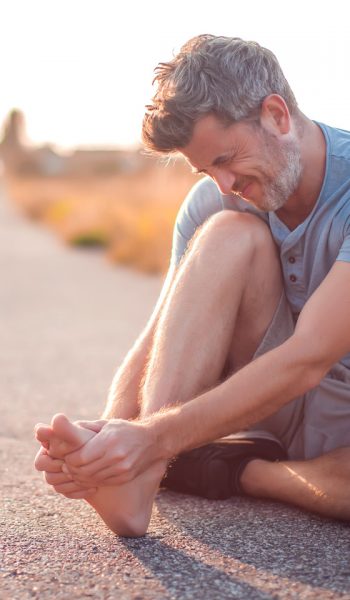What is Metatarsalgia?
Metatarsalgia frequently affects runners and other athletes who participate in high-impact sports. That’s because excessive amounts of running or jumping put extra stress on the metatarsals. These long bones located in the front part of your feet just below your toes connect the foot and ankle through the toes. People with certain foot shapes that create more stress on the metatarsal bones also may have these problems.
Although generally not serious, Metatarsalgia can sideline you, whether you’re an Olympic contender or a weekend warrior. Fortunately, conservative treatments such as ice packs, rest, and physical therapy can often relieve symptoms.
Wearing proper footwear, as well as special arch supports (orthotics), metatarsal foot pads, or nonprescription shock-absorbing shoe inserts, may be all you need to prevent or minimize future problems.

What is Metatarsalgia?
Metatarsalgia frequently affects runners and other athletes who participate in high-impact sports. That’s because excessive amounts of running or jumping put extra stress on the metatarsals. These long bones located in the front part of your feet just below your toes connect the foot and ankle through the toes. People with certain foot shapes that create more stress on the metatarsal bones also may have these problems.
Although generally not serious, Metatarsalgia can sideline you, whether you’re an Olympic contender or a weekend warrior. Fortunately, conservative treatments such as ice, rest, and physical therapy can often relieve pain and other symptoms.
Wearing proper footwear, as well as special arch supports (orthotics) or nonprescription shock-absorbing shoe inserts, may be all you need to prevent or minimize future problems.

Signs and symptoms
The main symptom of Metatarsalgia is pain in the ball of your foot — the part of the sole just behind your toes. The pain may be sharp, aching, or burning, and you may feel it in the area around the second, third, and fourth toes or only near your big toe.
Other symptoms of Metatarsalgia include:
- Pain that gets worse when you stand, walk or run, and that improves when you rest.
- Sharp or shooting pain in your toes.
- Numbness or tingling in your toes.
- Pain that worsens when you flex your feet.
- A feeling in your feet as if you’re walking on pebbles or have a bruise from a stone.
- Increased foot pain when you’re walking barefoot, especially on a hard surface.
Sometimes these symptoms come on suddenly, especially if you’ve recently increased your usual amount of running, jumping, or other high-impact exercises, but problems are more likely to develop over a period of months.
Signs and symptoms
The main symptom of Metatarsalgia is pain in the ball of your foot — the part of the sole just behind your toes. The pain may be sharp, aching, or burning, and you may feel it in the area around the second, third, and fourth toes or only near your big toe.
Other symptoms of Metatarsalgia include:
- Pain that gets worse when you stand, walk or run, and that improves when you rest.
- Sharp or shooting pain in your toes.
- Numbness or tingling in your toes.
- Pain that worsens when you flex your feet.
- A feeling in your feet as if you’re walking on pebbles or have a bruise from a stone.
- Increased foot pain when you’re walking barefoot, especially on a hard surface.
Sometimes these symptoms come on suddenly, especially if you’ve recently increased your usual amount of running, jumping, or other high-impact exercises, but problems are more likely to develop over a period of months.

Causes
In each foot, you have five metatarsal bones that run from your arch to your toe joints. The first metatarsal is shorter and thicker than the other four bones, which are usually similar in size. During the push-off phase when you walk, jump or run, your body weight is transferred to your toes and metatarsals. The first and second metatarsal bones take the brunt of this force, which can be as much as 275 percent of your body weight.
Most metatarsal problems develop when the impact load or the mechanics of your foot affect the way your weight is distributed. This can put excess pressure on the metatarsals, leading to inflammation and pain, especially in the metatarsal heads — the rounded ends of the bones that connect with your toe bones.
Sometimes a single factor can lead to Metatarsalgia, but more often several factors are involved, including:
Intense training or activity Runners have the highest incidence of Metatarsalgia, primarily because the front of the foot absorbs more force when running than during any other activity — as much as 110 tons of force per mile. But anyone who participates in a high-impact sport is at risk. Training intensely or for long periods puts even more stress on the metatarsals, often leading to chronic irritation, pain, and inflammation.
Certain foot shapes A high arch (pes cavus foot) can put extra pressure on the metatarsals. So can having a second toe that’s longer than your big toe, which causes more weight than normal to be shifted to the second metatarsal head.
Causes
In each foot, you have five metatarsal bones that run from your arch to your toe joints. The first metatarsal is shorter and thicker than the other four bones, which are usually similar in size. During the push-off phase when you walk, jump or run, your body weight is transferred to your toes and metatarsals. The first and second metatarsal bones take the brunt of this force, which can be as much as 275 percent of your body weight.
Most metatarsal problems develop when the impact load or the mechanics of your foot affect the way your weight is distributed. This can put excess pressure on the metatarsals, leading to inflammation and pain, especially in the metatarsal heads — the rounded ends of the bones that connect with your toe bones.
Sometimes a single factor can lead to Metatarsalgia, but more often several factors are involved, including:
Intense training or activity Runners have the highest incidence of Metatarsalgia, primarily because the front of the foot absorbs more force when running than during any other activity — as much as 110 tons of force per mile. But anyone who participates in a high-impact sport is at risk. Training intensely or for long periods puts even more stress on the metatarsals, often leading to chronic irritation and inflammation.
Certain foot shapes A high arch (pes cavus foot) can put extra pressure on the metatarsals. So can having a second toe that’s longer than your big toe, which causes more weight than normal to be shifted to the second metatarsal head.

Hammertoe
This foot problem has a genetic basis but can also develop when high heels or too-small shoes prevent your toes from lying flat. As a result, one of your toes — usually the second — curls downward because of a bend in the middle toe joint. This contraction depresses the metatarsal heads.
Bunion
This is a swollen, painful bump at the base of your big toe. Sometimes the tendency to develop bunions is inherited, but the problem can also result from wearing high heels or too-small shoes. Bunions are much more common in women than in men. A bunion can weaken your big toe, putting extra stress on the ball of your foot. Sometimes surgery to correct a bunion also can lead to Metatarsalgia.
Excess weight
Because most of your body weight transfers to your forefoot when you move, even a few extra pounds mean more pressure on your metatarsals. Sometimes just losing weight can reduce or eliminate symptoms of Metatarsalgia.
Poorly fitting shoes
High heels, which cause more weight to be transferred to the front of the foot, are one of the most common causes of Metatarsalgia in women. Shoes with a narrow toe box or athletic shoes that lack support and padding also can contribute to metatarsal problems.
Stress fractures
Small breaks in the metatarsals or toe bones can be painful and change the way you put weight on your foot.
Morton’s neuroma
This noncancerous growth of fibrous tissue most often occurs between the third and fourth metatarsal heads. It causes symptoms that are similar to Metatarsalgia and can also contribute to metatarsal stress. Morton’s neuroma frequently results from wearing high heels or too-tight shoes that put pressure on your toes. It can also develop after high-impact activities such as jogging and aerobics.
Aging
As you grow older, the fat pads on the balls of your feet become thinner, making the metatarsal bones more susceptible to injury.
Your podiatric physician/surgeon has been trained specifically and extensively in the diagnosis and treatment of all manners of foot conditions. This training encompasses all of the intricately related systems and structures of the foot and lower leg including neurological, circulatory, skin, and the musculoskeletal system, which includes bones, joints, ligaments, tendons, muscles, and nerves.
Hammertoe
This foot problem has a genetic basis but can also develop when high heels or too-small shoes prevent your toes from lying flat. As a result, one of your toes — usually the second — curls downward because of a bend in the middle toe joint. This contraction depresses the metatarsal heads.
Bunion
This is a swollen, painful bump at the base of your big toe. Sometimes the tendency to develop bunions is inherited, but the problem can also result from wearing high heels or too-small shoes. Bunions are much more common in women than in men. A bunion can weaken your big toe, putting extra stress on the ball of your foot. Sometimes surgery to correct a bunion also can lead to Metatarsalgia.
Excess weight
Because most of your body weight transfers to your forefoot when you move, even a few extra pounds mean more pressure on your metatarsals. Sometimes just losing weight can reduce or eliminate symptoms of Metatarsalgia.
Poorly fitting shoes
High heels, which cause more weight to be transferred to the front of the foot, are one of the most common causes of Metatarsalgia in women. Shoes with a narrow toe box or athletic shoes that lack support and padding also can contribute to metatarsal problems.
Stress fractures
Small breaks in the metatarsals or toe bones can be painful and change the way you put weight on your foot.
Morton’s neuroma
This noncancerous growth of fibrous tissue most often occurs between the third and fourth metatarsal heads. It causes symptoms that are similar to Metatarsalgia and can also contribute to metatarsal stress. Morton’s neuroma frequently results from wearing high heels or too-tight shoes that put pressure on your toes. It can also develop after high-impact activities such as jogging and aerobics.
Aging
As you grow older, the fat pads on the balls of your feet become thinner, making the metatarsal bones more susceptible to injury.
Your podiatric physician/surgeon has been trained specifically and extensively in the diagnosis and treatment of all manners of foot conditions. This training encompasses all of the intricately related systems and structures of the foot and lower leg including neurological, circulatory, skin, and the musculoskeletal system, which includes bones, joints, ligaments, tendons, muscles, and nerves. Reach out to our team for expert medical advice.
